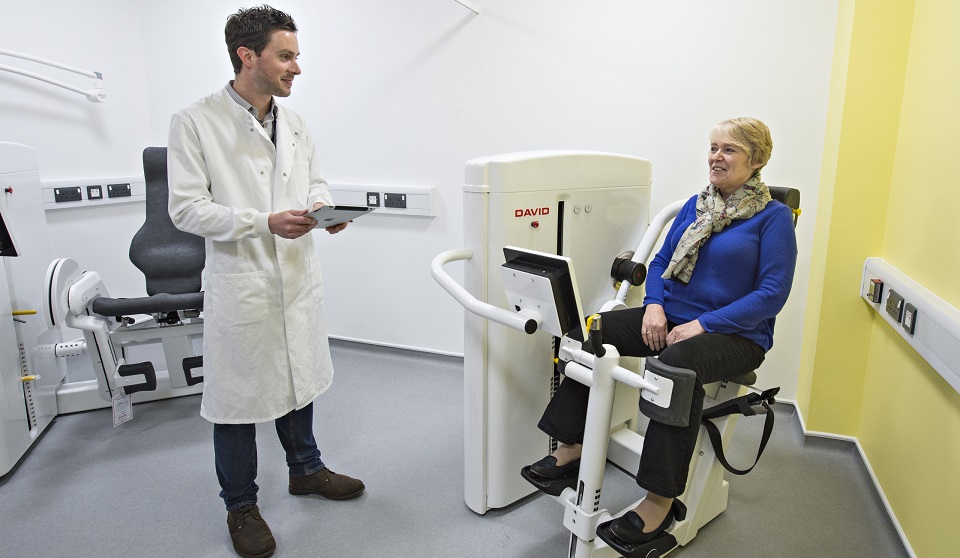-
Table of Contents
“Transforming lives through cutting-edge rehabilitation solutions.”
Introduction:
Innovations in Rehabilitation Medicine have revolutionized the field of healthcare by providing advanced techniques, technologies, and therapies to improve the quality of life for individuals with disabilities or injuries. These innovations encompass a wide range of approaches, including the use of robotics, virtual reality, neurorehabilitation, and regenerative medicine. By combining cutting-edge research and technology, rehabilitation medicine has made significant strides in enhancing functional abilities, promoting recovery, and restoring independence for patients. This article explores some of the key innovations in rehabilitation medicine and their impact on patient care.
Advancements in Robotic Rehabilitation Technology
Advancements in Robotic Rehabilitation Technology
In recent years, there have been significant advancements in the field of rehabilitation medicine, particularly in the area of robotic rehabilitation technology. This innovative approach to rehabilitation has revolutionized the way patients recover from injuries and regain their independence. Robotic rehabilitation technology offers a wide range of benefits, including increased efficiency, improved patient outcomes, and enhanced patient engagement.
One of the key advantages of robotic rehabilitation technology is its ability to provide more precise and controlled movements during therapy sessions. Traditional rehabilitation methods often rely on manual techniques, which can be limited in their ability to deliver consistent and accurate movements. With robotic technology, therapists can program specific movements and adjust the intensity and speed of the exercises to meet each patient’s unique needs. This level of precision allows for more targeted therapy, resulting in better outcomes for patients.
Furthermore, robotic rehabilitation technology offers a higher level of efficiency compared to traditional methods. With the use of robotic devices, therapists can simultaneously treat multiple patients, reducing the need for one-on-one sessions. This not only saves time but also allows therapists to focus on other aspects of patient care, such as monitoring progress and providing emotional support. Additionally, robotic devices can be programmed to provide repetitive exercises, which are often necessary for optimal recovery. This eliminates the need for therapists to manually perform these exercises, freeing up their time for other important tasks.
Another significant benefit of robotic rehabilitation technology is its ability to engage patients in their own recovery process. Traditional rehabilitation methods can sometimes be monotonous and repetitive, leading to decreased motivation and adherence to therapy. However, robotic devices offer interactive and engaging experiences for patients. Many robotic devices are equipped with virtual reality technology, which allows patients to participate in immersive and enjoyable therapy sessions. This not only makes the rehabilitation process more enjoyable but also encourages patients to actively participate in their own recovery.
Moreover, robotic rehabilitation technology has the potential to improve patient outcomes by providing real-time feedback and monitoring. Many robotic devices are equipped with sensors that can track a patient’s progress and provide immediate feedback on their performance. This allows therapists to make necessary adjustments to the therapy program and ensure that patients are performing exercises correctly. Additionally, the data collected by these devices can be analyzed to identify trends and patterns, which can inform future treatment plans and improve overall patient care.
In conclusion, advancements in robotic rehabilitation technology have transformed the field of rehabilitation medicine. The precision, efficiency, patient engagement, and real-time feedback provided by robotic devices have revolutionized the way patients recover from injuries and regain their independence. As technology continues to advance, it is likely that robotic rehabilitation technology will become even more sophisticated, further enhancing patient outcomes and improving the overall quality of care in rehabilitation medicine.
Emerging Trends in Virtual Reality-based Rehabilitation
Emerging Trends in Virtual Reality-based Rehabilitation
In recent years, virtual reality (VR) technology has made significant advancements, and its potential applications in various fields are being explored. One area where VR is gaining traction is rehabilitation medicine. Virtual reality-based rehabilitation is an innovative approach that uses immersive technology to enhance the recovery process for individuals with physical and cognitive impairments. This article will discuss the emerging trends in virtual reality-based rehabilitation and the potential benefits it offers.
One of the key trends in virtual reality-based rehabilitation is the use of VR simulations for motor rehabilitation. Traditional rehabilitation methods often involve repetitive exercises that can be monotonous and demotivating for patients. However, with VR, patients can engage in interactive and engaging activities that simulate real-life scenarios. For example, a stroke patient can use VR to practice reaching and grasping objects in a virtual environment, which can help improve their motor skills and coordination.
Another trend in virtual reality-based rehabilitation is the use of VR for cognitive rehabilitation. Cognitive impairments, such as memory loss and attention deficits, can significantly impact a person’s daily functioning. VR technology can create virtual environments that challenge and stimulate cognitive abilities. For instance, a person with a traumatic brain injury can use VR to practice memory tasks or problem-solving exercises, which can aid in their cognitive recovery.
Furthermore, virtual reality-based rehabilitation is also being used for pain management. Chronic pain is a common issue among individuals with various medical conditions. VR can provide a distraction from pain by immersing patients in virtual environments that are visually and audibly engaging. By redirecting the patient’s attention, VR can help reduce the perception of pain and improve overall well-being.
Additionally, virtual reality-based rehabilitation is being integrated with other technologies to enhance its effectiveness. For example, motion capture technology can be used in conjunction with VR to track a patient’s movements and provide real-time feedback. This allows therapists to monitor progress and make adjustments to the rehabilitation program accordingly. Similarly, haptic feedback devices can be incorporated into VR simulations to provide tactile sensations, further enhancing the immersive experience.
The benefits of virtual reality-based rehabilitation are not limited to the clinical setting. VR technology allows for remote rehabilitation, enabling patients to receive therapy from the comfort of their homes. This is particularly beneficial for individuals who have limited mobility or live in remote areas with limited access to rehabilitation services. Remote rehabilitation also reduces the need for frequent travel to healthcare facilities, saving time and resources for both patients and healthcare providers.
Despite the promising potential of virtual reality-based rehabilitation, there are still challenges that need to be addressed. Cost and accessibility are significant barriers, as VR equipment can be expensive, and not all healthcare facilities have the resources to implement this technology. Additionally, more research is needed to establish the efficacy of virtual reality-based rehabilitation compared to traditional methods.
In conclusion, virtual reality-based rehabilitation is an emerging trend in the field of rehabilitation medicine. It offers innovative solutions for motor and cognitive rehabilitation, pain management, and remote therapy. By providing immersive and engaging experiences, VR has the potential to revolutionize the way rehabilitation is delivered. However, further research and investment are necessary to overcome the challenges and fully harness the benefits of this technology.
The Role of Artificial Intelligence in Rehabilitation Medicine
In recent years, there have been significant advancements in the field of rehabilitation medicine. One of the most notable innovations is the integration of artificial intelligence (AI) into the rehabilitation process. AI has the potential to revolutionize the way patients recover from injuries and regain their independence.
Artificial intelligence refers to the development of computer systems that can perform tasks that would typically require human intelligence. In the context of rehabilitation medicine, AI can be used to analyze patient data, develop personalized treatment plans, and monitor progress throughout the recovery process.
One of the key benefits of using AI in rehabilitation medicine is the ability to analyze large amounts of patient data quickly and accurately. Traditionally, healthcare professionals would have to manually review patient records and test results to develop a treatment plan. This process can be time-consuming and prone to human error. With AI, algorithms can analyze vast amounts of data in a fraction of the time, allowing for more efficient and accurate treatment planning.
Additionally, AI can help healthcare professionals develop personalized treatment plans for each patient. By analyzing a patient’s medical history, physical capabilities, and goals, AI algorithms can generate tailored rehabilitation programs that are specific to the individual’s needs. This personalized approach can lead to better outcomes and faster recovery times.
Furthermore, AI can play a crucial role in monitoring patient progress throughout the rehabilitation process. By using sensors and wearable devices, AI algorithms can track a patient’s movements, range of motion, and strength. This real-time data can provide valuable insights into a patient’s progress and allow healthcare professionals to make adjustments to the treatment plan as needed.
Another area where AI is making a significant impact is in the development of assistive technologies. These technologies aim to enhance the independence and quality of life for individuals with disabilities. AI-powered devices, such as exoskeletons and robotic prosthetics, can help individuals regain mobility and perform daily tasks with greater ease. These devices use AI algorithms to interpret signals from the user’s brain or muscles and translate them into movements.
While the integration of AI into rehabilitation medicine holds great promise, there are also challenges that need to be addressed. One of the main concerns is the ethical use of AI in healthcare. As AI algorithms become more sophisticated, there is a need to ensure that they are used in a way that respects patient privacy and autonomy. Additionally, there is a need for ongoing research and development to improve the accuracy and reliability of AI algorithms in the rehabilitation context.
In conclusion, the role of artificial intelligence in rehabilitation medicine is rapidly evolving. AI has the potential to transform the way patients recover from injuries and regain their independence. By analyzing patient data, developing personalized treatment plans, and monitoring progress, AI can enhance the efficiency and effectiveness of rehabilitation programs. Additionally, AI-powered assistive technologies can help individuals with disabilities regain mobility and improve their quality of life. However, it is essential to address ethical concerns and continue to research and develop AI algorithms to ensure their accuracy and reliability. With further advancements in AI, the future of rehabilitation medicine looks promising.In conclusion, innovations in rehabilitation medicine have significantly improved the quality of care and outcomes for patients. Advancements in technology, such as virtual reality, robotics, and wearable devices, have allowed for more personalized and effective rehabilitation interventions. These innovations have also enhanced patient engagement and motivation, leading to better adherence to treatment plans. Additionally, the integration of data analytics and artificial intelligence has enabled healthcare professionals to make more informed decisions and tailor rehabilitation programs to individual needs. Overall, these innovations hold great promise in further advancing the field of rehabilitation medicine and improving the lives of patients.





